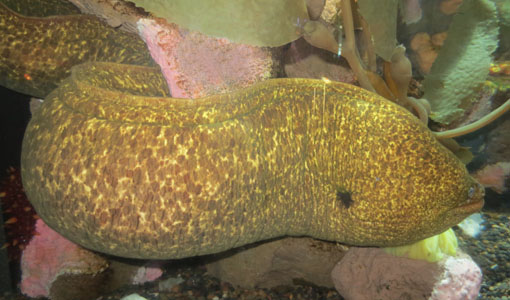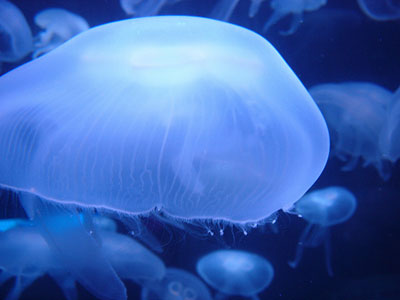Halloween is quickly approaching, with it comes all kinds of ghoulish creatures like zombies, aliens, ghosts and more. If you spend all year anxiously waiting for the monsters to come out, youíll be delighted to find out that you donít need to wait until Halloween to meet these freaky fiends.

Photo courtesy of Aquarium of the Bay
By Mallory Johnson
Published: October, 2013
Halloween is quickly approaching, with it comes all kinds of ghoulish creatures like zombies, aliens, ghosts and more. If you spend all year anxiously waiting for the monsters to come out, you’ll be delighted to find out that you don’t need to wait until Halloween to meet these freaky fiends. There are plenty of "monsters" right here in San Francisco Bay.
Moon jellies
Brainless, boneless and 95 percent liquid, these mysterious creatures combine all of our favorite monsters into one. With their transparent bodies, moon jellies seem to resemble ghosts or aliens more than anything you should find on our planet. However, jellies have inhabited earth—more specifically, the ocean—longer than almost any other species, dating back over 650 million years. What moon jellies lack in brains and bones, they make up for with stomachs—four of them, to be exact. With little control over their own movement, these jellies move like (graceful) zombies, mindlessly pulsing as they drift on ocean currents.
Moon jellies have a unique way of reproducing: they clone themselves (sort of)! Moon jellies go through multiple stages of reproduction, beginning with sexual egg fertilization. A few stages later, however, these jellies begin a process called strobilation. Also known as asexual reproduction, strobilation is a process in which the polyp divides itself into multiple segments before the tiny clones float away and develop into genetically identical adult jellies.
Giant Pacific octopus
What’s got eight arms, three hearts and no bones? It’s the giant Pacific octopus, of course! When considering their amazing abilities, these cephalopods seem to defy all reason. Weighing in at an average of 50 pounds, giant Pacific octopuses exhibit great feats of strength. When using all eight arms, the giant Pacific octopus can move more than 700 pounds. That’s 14 times its own weight! A female giant Pacific octopus has 280 suckers on each arm, totaling 2,240 suckers. A male octopus, meanwhile, has 100 fewer suckers than its female counterpart. With no skeleton to restrict its movement and get in the way, a giant Pacific octopus can squeeze its body into incredibly small spaces.
Masters of disguise, a giant Pacific octopus can change its color within a fraction of a second by stretching or squeezing its skin, a clever defense mechanism made possible by millions of elastic skin cells with colored pigments. That’s not the only way the giant Pacific octopus deters predators. When threatened, an octopus can shoot out an inky substance as it quickly swims away, creating an instant smokescreen to throw off its would-be attacker. In fact, sometimes the ink cloud can even take the actual shape of an octopus, providing an extra diversion that allows the real octopus to escape from predators. In a pinch, a giant Pacific octopus can even leave behind an arm to get out of a sticky situation and grow it back later on.
Green moray eels
There are quite a few traits about moray eels that qualify this creature for the category of "freaky fish." Despite its name, green moray eels are actually brown. This eel secretes a yellow mucus all over its body to protect it from parasites and diseases, giving the animal the illusion of being green. Moray eels look intimidating thanks to the way they constantly open and close their mouths. Despite the menacing look this movement gives them, it’s actually more of a survival technique than an invitation for a fight; they do this to pump water through their gills for respiration. In fact, moray eels actually prefer their alone time and tend to spend most of it hidden in burrows or crevices. They can often be seen with just their heads protruding from their hiding spots, giving them an added element of mystery.
Green moray eels have long, slender bodies that are flattened from side to side. Because of their shape, their heads are too narrow to swallow in the same way that most other fish do. While this sounds like it should be problematic, they actually have their own way of working around this limitation. Moray eels have two sets of jaws: a powerful outer jaw and a second, inner pharyngeal jaw located inside the throat. When dinner time rolls around, the moray eel will clamp down on its prey with its first set off jaws. Meanwhile, its pharyngeal jaw will protrude from its throat to grab the food and carry it back down—think Ridley Scott’s Alien—all within fraction of a second.
You can find out more about these underwater monsters and other freaky fish in person any time at Aquarium of the Bay. For more information, visit www.aquariumofthebay.org.
Mallory Johnson is the Public Relations Coordinator for Aquarium of the Bay, a nonprofit organization dedicated to protecting, restoring and inspiring the conservation of San Francisco Bay and its watershed.

Green moray eels have long, slender bodies that are flattened from side to side. They prefer to be alone and tend to spend most of their time hidden in burrows or crevices. Photo courtesy of Aquarium of the Bay

Jellies have inhabited earth longer than almost any other species, dating back over 650 million years. Photo courtesy of Aquarium of the Bay

